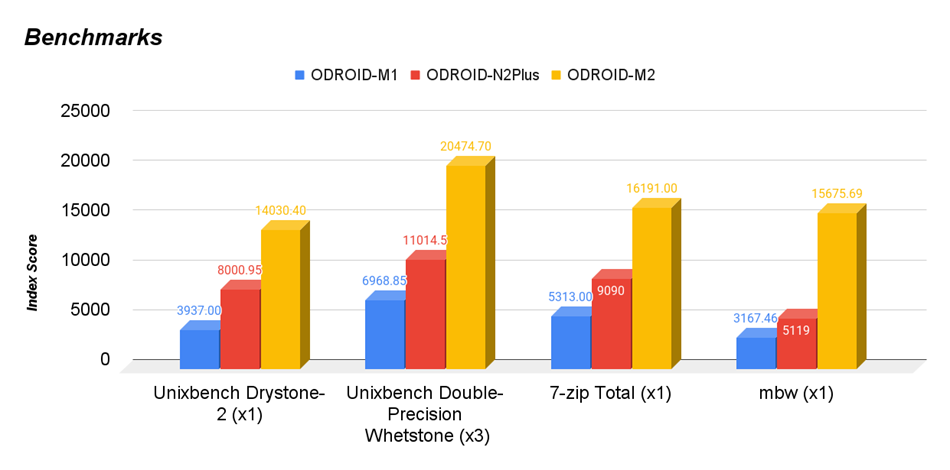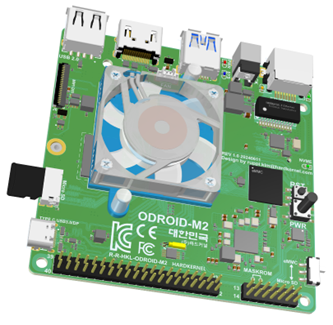
The M2 is a striking high-performance SBC compared to the M1 series
We launched the ODROID-M1 about 2 years ago, and the ODROID-M1S about 1 year ago. Both models have been successfully supplied and continue to be adopted as core components in embedded systems by our B2B customers.
We received feedback that the performance and input/output port configuration of the ODROID-M1/M1S were sufficient for most embedded systems. However, some customers still wanted higher-end models equipped with high-performance processors.
To meet the demand for higher-performance computing power required by important industrial embedded system builders, we have launched the new ODROID-M2 SBC.


Compared to the original ODROID-M1 (based on the RK3568B2 SoC), the ODROID-M2 uses the RK3588S2 SoC whose comparative characteristics are listed below:
- Multiprocessing performance is about 3 times faster.
- LPDDR5 64-bit RAM with a memory bandwidth that is more than twice as high.
- A GPU that is more than 5 times faster.
- A NPU that is more than 3 times faster.
- An onboard 64GB eMMC storage device which is twice as fast thanks to an HS400 interface.
The RK3588S2 SoC with multiple high-performance CPU/GPU cores and large cache memory blocks, is manufactured in the Samsung Foundry’s 8N process and has the advantage of relatively low power consumption compared to performance.


Thanks to the high-speed 64-bit LPDDR5 memory and high-performance GPU, it shows very usable graphics performance in a 4K dual-head display configuration. We connected two 4K monitors using the M2 board’s HDMI port and the Alt-mode USB Type-C port. This demo shows 4K 3D rendering using HW GPU acceleration on the first monitor, and 4K video playback using HW VPU acceleration on the second monitor. Since hardware accelerators are used to run high-end graphics applications, the cooling fan rarely rotates because it does not generate a lot of heat.
4K Dual-head display demo video
The M2 is a striking high-performance SBC compared to the M1 series
We launched the ODROID-M1 about 2 years ago, and the ODROID-M1S about 1 year ago. Both models have been successfully supplied and continue to be adopted as core components in embedded systems by our B2B customers.
We received feedback that the performance and input/output port configuration of the ODROID-M1/M1S were sufficient for most embedded systems. However, some customers still wanted higher-end models equipped with high-performance processors.
To meet the demand for higher-performance computing power required by important industrial embedded system builders, we have launched the new ODROID-M2 SBC.


Compared to the original ODROID-M1 (based on the RK3568B2 SoC), the ODROID-M2 uses the RK3588S2 SoC whose comparative characteristics are listed below:
- Multiprocessing performance is about 3 times faster.
- LPDDR5 64-bit RAM with a memory bandwidth that is more than twice as high.
- A GPU that is more than 5 times faster.
- A NPU that is more than 3 times faster.
- An onboard 64GB eMMC storage device which is twice as fast thanks to an HS400 interface.
The RK3588S2 SoC with multiple high-performance CPU/GPU cores and large cache memory blocks, is manufactured in the Samsung Foundry’s 8N process and has the advantage of relatively low power consumption compared to performance.


Thanks to the high-speed 64-bit LPDDR5 memory and high-performance GPU, it shows very usable graphics performance in a 4K dual-head display configuration. We connected two 4K monitors using the M2 board’s HDMI port and the Alt-mode USB Type-C port. This demo shows 4K 3D rendering using HW GPU acceleration on the first monitor, and 4K video playback using HW VPU acceleration on the second monitor. Since hardware accelerators are used to run high-end graphics applications, the cooling fan rarely rotates because it does not generate a lot of heat.
4K Dual-head display demo video
For detailed internal configuration, please refer to the block diagram shown below.

For detailed internal configuration, please refer to the block diagram shown below.

On-board eMMC storage
For the first time in the ODROID board series, an eMMC chip is soldered to the PCB by default instead of using a removable eMMC module. We think 64GB capacity is sufficient for building most embedded systems solutions in this category
The sequential access speed of the onboard eMMC is approximately 260MB/s, which is about 3 to 5 times faster than typical microSD cards. Note that the ODROID-M1 series supports the eMMC interface of the HS200 specification, but the ODROID-M2 supports the much faster, HS400 specification.
Benchmark
ODROID-M1 ODROID-M2
iozone 1M random read 144.29 MB/s 273.25 MB/s iozone 1M random write 129.45 MB/s 254.15 MB/s iozone 4K random read 27.52 MB/s 27.86 MB/s iozone 4K random write 41.85 MB/s 52.9 MB/s
On-board M.2 NVMe slot
In case the 64GB storage space of the soldered eMMC memory is insufficient, consider using an industry-standard M.2 2280 form factor NVMe SSD. An on-board M.2 NVMe slot is provided to access large amounts of data storage.
Unlike the original M1 model’s PCIe 3.0 x 2 lanes configuration, the M2 has PCIe 2.1 x 1 lane. The NVMe transfer speed of the M2 has been reduced by about 1/4. However, we still believe that ~400 MiB/s of storage access speed is sufficient for building various high-end embedded systems. Note that M.2 SATA SSD storage devices cannot be used. The M.2 slot supports only the PCIe SSD (M-Key).

For the first time in the ODROID board series, an eMMC chip is soldered to the PCB by default instead of using a removable eMMC module. We think 64GB capacity is sufficient for building most embedded systems solutions in this category
The sequential access speed of the onboard eMMC is approximately 260MB/s, which is about 3 to 5 times faster than typical microSD cards. Note that the ODROID-M1 series supports the eMMC interface of the HS200 specification, but the ODROID-M2 supports the much faster, HS400 specification.
Benchmark | ODROID-M1 | ODROID-M2 |
| iozone 1M random read | 144.29 MB/s | 273.25 MB/s |
| iozone 1M random write | 129.45 MB/s | 254.15 MB/s |
| iozone 4K random read | 27.52 MB/s | 27.86 MB/s |
| iozone 4K random write | 41.85 MB/s | 52.9 MB/s |
On-board M.2 NVMe slot
In case the 64GB storage space of the soldered eMMC memory is insufficient, consider using an industry-standard M.2 2280 form factor NVMe SSD. An on-board M.2 NVMe slot is provided to access large amounts of data storage.
Unlike the original M1 model’s PCIe 3.0 x 2 lanes configuration, the M2 has PCIe 2.1 x 1 lane. The NVMe transfer speed of the M2 has been reduced by about 1/4. However, we still believe that ~400 MiB/s of storage access speed is sufficient for building various high-end embedded systems. Note that M.2 SATA SSD storage devices cannot be used. The M.2 slot supports only the PCIe SSD (M-Key).

Real-Time Clock
The ODROID-M2 has a hardware Real-Time Clock (RTC) and calendar function by embedding the low-power optimized PCF8563 chip. By installing just one CR2032 RTC backup battery, the clock and calendar will continue to operate for nearly 10 years without a main power supply. The battery is not supplied and must be purchased separately.
The ODROID-M2 has a hardware Real-Time Clock (RTC) and calendar function by embedding the low-power optimized PCF8563 chip. By installing just one CR2032 RTC backup battery, the clock and calendar will continue to operate for nearly 10 years without a main power supply. The battery is not supplied and must be purchased separately.
Heatsink cooling fan
A high-performance octa-core single-board computer requires power consumption close to 8 watts when the CPU and GPU are continuously subjected to high-computing loads. At this time, considerable heat is generated and a cooling fan is inevitably needed to avoid thermal throttling of the SoC. Accordingly, the cooling fan is included in the kit. The speed of the cooling fan can be controlled using PWM.
A high-performance octa-core single-board computer requires power consumption close to 8 watts when the CPU and GPU are continuously subjected to high-computing loads. At this time, considerable heat is generated and a cooling fan is inevitably needed to avoid thermal throttling of the SoC. Accordingly, the cooling fan is included in the kit. The speed of the cooling fan can be controlled using PWM.
Free case
Using 3D modelling from the early PCB design stage, we were able to complete the case development precisely and rapidly. The case is also included in the kit.
SBC 3D model and case



Using 3D modelling from the early PCB design stage, we were able to complete the case development precisely and rapidly. The case is also included in the kit.
SBC 3D model and case



ODROID-M2 with 16GByte RAM [12001]
- Brand: Hard Kernel
- Product Code: ODROID-M2 with 16GByte RAM [12001]
- Availability: In Stock
-
178.02€
- Ex Tax: 148.35€

![ODROID-M2 with 16GByte RAM [12001] ODROID-M2 with 16GByte RAM [12001]](https://www.odroid.co.uk/image/cache/catalog/odroidM2b-500x500.jpg)
![ODROID-M2 with 16GByte RAM [12001] ODROID-M2 with 16GByte RAM [12001]](https://www.odroid.co.uk/image/cache/catalog/odroidM2boardnm-74x74.jpg)
![ODROID-M2 with 16GByte RAM [12001] ODROID-M2 with 16GByte RAM [12001]](https://www.odroid.co.uk/image/cache/catalog/Case-74x74.gif)
![ODROID-M2 with 16GByte RAM [12001] ODROID-M2 with 16GByte RAM [12001]](https://www.odroid.co.uk/image/cache/catalog/odroidM2a-74x74.jpg)
![ODROID-M2 with 16GByte RAM [12001] ODROID-M2 with 16GByte RAM [12001]](https://www.odroid.co.uk/image/cache/catalog/odroidM2c-74x74.jpg)
![ODROID-M2 with 16GByte RAM [12001] ODROID-M2 with 16GByte RAM [12001]](https://www.odroid.co.uk/image/cache/catalog/odroidM2b-74x74.jpg)
![ODROID-M2 with 16GByte RAM [12001] ODROID-M2 with 16GByte RAM [12001]](https://www.odroid.co.uk/image/cache/catalog/odroidM2boarda-74x74.jpg)
![ODROID-M2 with 16GByte RAM [12001] ODROID-M2 with 16GByte RAM [12001]](https://www.odroid.co.uk/image/cache/catalog/odroidM2boardb-74x74.jpg)
![ODROID-M2 with 16GByte RAM [12001] ODROID-M2 with 16GByte RAM [12001]](https://www.odroid.co.uk/image/cache/catalog/odroidM2e-74x74.jpg)
![ODROID-M2 with 16GByte RAM [12001] ODROID-M2 with 16GByte RAM [12001]](https://www.odroid.co.uk/image/cache/catalog/board-2-74x74.png)
![ODROID-M2 with 16GByte RAM [12001] ODROID-M2 with 16GByte RAM [12001]](https://www.odroid.co.uk/image/cache/catalog/odroidM2ssd-74x74.jpg)
![ODROID-M2 with 16GByte RAM [12001] ODROID-M2 with 16GByte RAM [12001]](https://www.odroid.co.uk/image/cache/catalog/board-1-74x74.png)
![ODROID-M2 with 16GByte RAM [12001] ODROID-M2 with 16GByte RAM [12001]](https://www.odroid.co.uk/image/cache/catalog/odroidM2d-74x74.jpg)
![ODROID-M2 with 16GByte RAM [12001] ODROID-M2 with 16GByte RAM [12001]](https://www.odroid.co.uk/image/cache/catalog/odroidM2caseb-768x582-74x74.jpg)